

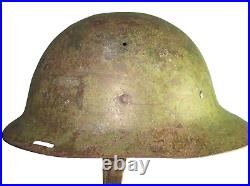
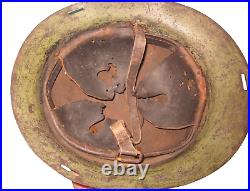
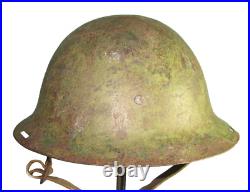
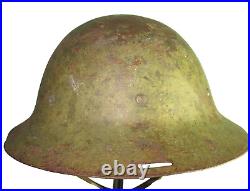

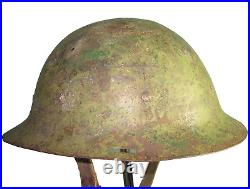
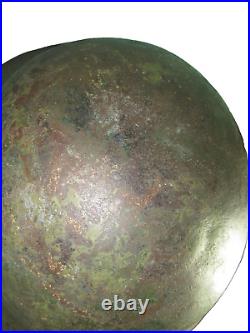
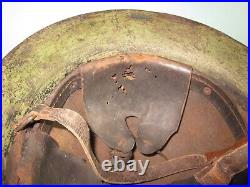
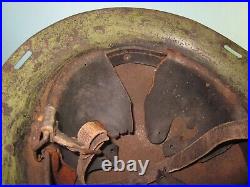
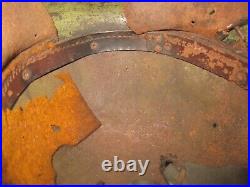
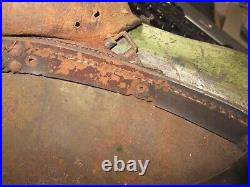
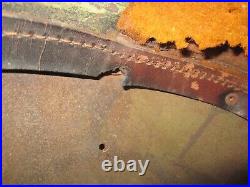
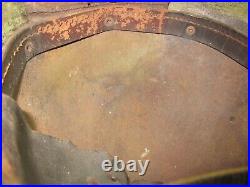

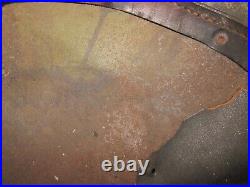
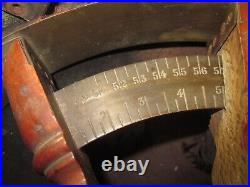

If you have doubts, questions or need advice: please contact me. You get answer within a day. Please ask an invoice before you pay. Size: ca 57 cm. All details are original: Original sanded paint, early liner and original chin strap (8 cm shorter than from production). The M16A has two air ventilation holes and 3 oblong holes in the brim. The Mod16B has three oblong holes in the brim and no air ventures in the bowl, the Mod16C and Mod16D had one oblong hole. It was used by the army until the introduction of the M27 steel helmet. When the Dutch Army went short of helmets in the’30’s it was re-introduced. A rare helmet that will take a unique place in a high-end quality helmet collection. Have a good look at the photos and please see my other ads as well. Sie bieten auf einen niederländischen Helm Mod16A mit Originalfutter und Kinnriemen. Original abgeschliffener Lack, frühes Futter und Originalkinnriemen (8 cm kürzer als bei der Produktion). Der M16A hat zwei Belüftungslöcher und 3 Langlöcher in der Krempe. Der Mod16B hat drei Langlöcher in der Krempe und keine Belüftungsöffnungen in der Helmschale, der Mod16C und der Mod16D hatten ein Langloch. Er wurde von der Armee bis zur Einführung des Stahlhelms M27 verwendet. Als die niederländische Armee in den 30er Jahren einen Mangel an Helmen hatte, wurde er wieder eingeführt. Ein seltener Helm, der einen einzigartigen Platz in einer hochwertigen Helmsammlung einnehmen wird. Schauen Sie sich die Fotos genau an und schauen Sie sich auch meine anderen Anzeigen an. Vous enchérissez sur un casque hollandais Mod16A avec doublure et mentonnière d’origine. Peinture poncée d’origine, doublure ancienne et mentonnière d’origine (8 cm plus courte que celle de production). Le modèle 16 a été introduit lors de la mobilisation aux Pays-Bas de 1914 à 1918, Première Guerre mondiale. Le M16A a deux trous de ventilation d’air et 3 trous oblongs dans le bord. Le Mod16B a trois trous oblongs dans le bord et aucune ouverture d’air dans la cuvette, les Mod16C et Mod16D avaient un trou oblong. Il a été utilisé par l’armée jusqu’à l’introduction du casque en acier M27. Lorsque l’armée néerlandaise s’est retrouvée à court de casques dans les années 30, il a été réintroduit. Un casque rare qui occupera une place unique dans une collection de casques haut de gamme. Regardez bien les photos et consultez également mes autres annonces. Estás pujando por un casco holandés Mod16A con forro y correa de barbilla originales. Pintura lijada original, forro antiguo y correa de barbilla original (8 cm más corta que la de producción). El modelo 16 se introdujo durante la movilización en los Países Bajos de 1914 a 1918, Primera Guerra Mundial. El M16A tiene dos orificios de ventilación y 3 orificios oblongos en el ala. El Mod16B tiene tres orificios oblongos en el ala y no tiene orificios de ventilación en la cazoleta; el Mod16C y el Mod16D tenían un orificio oblongo. Fue utilizado por el ejército hasta la introducción del casco de acero M27. Cuando el ejército holandés se quedó sin cascos en los años 30, se volvió a introducir. Un casco raro que ocupará un lugar único en una colección de cascos de alta calidad. Mire atentamente las fotos y vea también mis otros anuncios. Stai offrendo un elmetto olandese Mod16A con fodera e sottogola originali. Vernice originale levigata, fodera iniziale e sottogola originale (8 cm più corta rispetto alla produzione). L’M16A ha due fori di ventilazione e 3 fori oblunghi nella visiera. Il Mod16B ha tre fori oblunghi nella visiera e nessuna presa d’aria nella calotta, il Mod16C e il Mod16D avevano un foro oblungo. Fu utilizzato dall’esercito fino all’introduzione dell’elmetto in acciaio M27. Quando l’esercito olandese si ritrovò a corto di elmetti negli anni’30, fu reintrodotto. Un elmetto raro che occuperà un posto unico in una collezione di elmetti di alta qualità. Osservate attentamente le foto e date un’occhiata anche ai miei altri annunci. Mod16A?? (8)???????????????????????????? Mod16A?????????????????????????????? (?? 8 cm?)??? 16???????? 1914 ~ 1918??????? M16A??? 2??????? 3????????? Mod16B?????? 3??????????????????? Mod16C? Mod16D????? 1?????? M27?????????????????????????



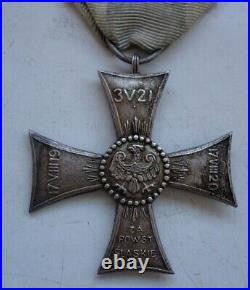
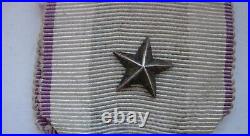
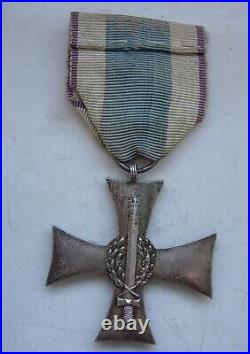

Correct “moire” old ribbon + combat star, size about 42mm x 42mm. In the latter-day history of Poland after World War II, the insurrections were celebrated as centrepieces of national pride. WHAT YOU-SEE-IS-WHAT YOU GET. This item is in the category “Collectibles\Militaria\1919-38\Original Period Items”. The seller is “plmilitary” and is located in this country: PL.
- Theme: Militaria
- Original/Reproduction: Original
- Country/Region of Manufacture: Poland


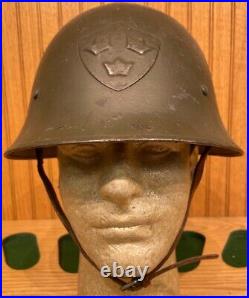

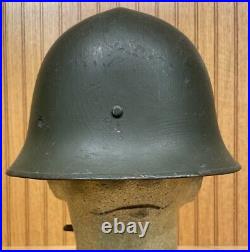
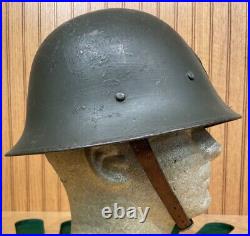

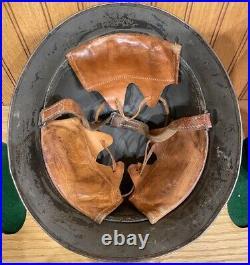

Description: Very nice overall condition as pictured. Hi, we are an operating shop located in Tamaqua, PA. We will be doing our best to accurately identify and describe each helmet but please keep in mind that we are not collectors of helmets so there may be some things we get wrong such as terminology or timeframe of manufacture/use. Sizing: When we are able to identify a size we list it and, if applicable, picture it. If there is no size listed and there is no picture of a size then we have no idea. While I use the term’we’, this is basically a one person operation. We picture each item as well is required for its condition and the pictures are taken with the intent to make any issues look worse than they are. Asking us why or if we will make an exception will go unanswered. This item is in the category “Collectibles\Militaria\1919-38\Original Period Items”. The seller is “edssport” and is located in this country: US. This item can be shipped to United States.
- Modified Item: No
- Country/Region of Manufacture: Sweden
- Theme: Militaria
- Original/Reproduction: Original
- Time Period Manufactured: 1919-38


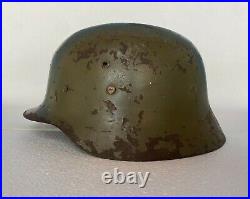
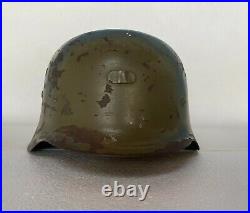
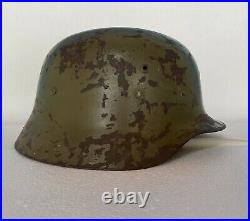
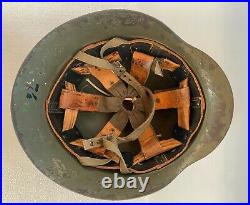

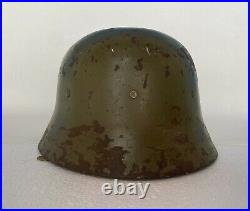
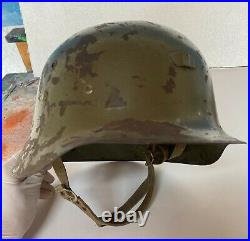

Nice solid helmet with numerous paint chips exposing light surface rust. What you see is what you get. This item is in the category “Collectibles\Militaria\1919-38\Original Period Items”. The seller is “ausganger” and is located in this country: US. This item can be shipped to United States, Canada, United Kingdom, Denmark, Romania, Slovakia, Bulgaria, Czech Republic, Finland, Hungary, Latvia, Lithuania, Malta, Estonia, Australia, Greece, Portugal, Cyprus, Slovenia, Japan, China, Sweden, Korea, South, Indonesia, Taiwan, South Africa, Thailand, Belgium, France, Ireland, Netherlands, Poland, Spain, Italy, Germany, Austria, Bahamas, Israel, Mexico, New Zealand, Philippines, Singapore, Switzerland, Norway, Saudi Arabia, United Arab Emirates, Qatar, Kuwait, Bahrain, Croatia, Republic of, Chile, Colombia, Costa Rica, Dominican Republic, Panama, Trinidad and Tobago, Guatemala, El Salvador, Honduras, Jamaica, Antigua and Barbuda, Aruba, Belize, Dominica, Grenada, Saint Kitts-Nevis, Saint Lucia, Montserrat, Turks and Caicos Islands, Barbados, Bangladesh, Bermuda, Brunei Darussalam, Bolivia, Egypt, French Guiana, Guernsey, Gibraltar, Guadeloupe, Iceland, Jersey, Jordan, Cambodia, Cayman Islands, Liechtenstein, Sri Lanka, Luxembourg, Monaco, Macau, Martinique, Maldives, Nicaragua, Oman, Pakistan, Paraguay, Reunion, Uruguay.
- Modification Description: M26 refurbished after the end of the SCW
- Theme: Militaria
- Original/Reproduction: Original
- Featured Refinements: Spanish Civil War
- Time Period Manufactured: 1919-38
- Country/Region of Manufacture: Spain
- Modified Item: No



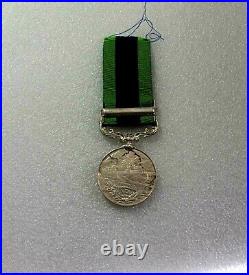

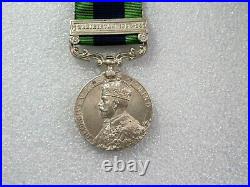
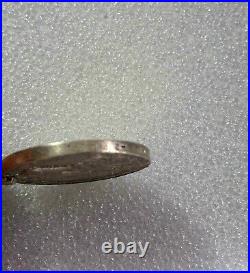

Awarded to BRITISH & INDIAN UNITS who served in the WAZIRISTAN area from December 1921 – to March 1924. STAMPED ON THE EDGE 553 SEP. 1 – 2 PJB. ORIGINAL MEDAL WITH ORIGINAL BAR & RIBBON. MADE FROM SOLID STERLING SILVER, 44 GRAMS WEIGHT. PERFECT FOR YOUR MILITARTY COLLECTION. Track Page Views With. Auctiva’s FREE Counter. This item is in the category “Collectibles\Militaria\1919-38\Original Period Items”. The seller is “rokas” and is located in this country: CA. This item can be shipped worldwide.
- Modified Item: No
- Country/Region of Manufacture: United Kingdom
- Theme: Militaria
- Original/Reproduction: Original
- Time Period Manufactured: 1919-38


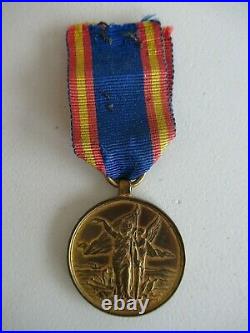


100% ORIGINAL ISSUE PIECE. Argentina, Brazil, Chile, Colombia, Romania, Bulgaria, Mexico, China, Macau, Turkey, United Arab Emirates, Montenegro. CANADA, USA, UK, IRELAND, AUSTRIA, DENMARK, SWEDEN, NORWAY, FINLAND, GERMANY, FRANCE, BELGIUM, ITALY, SWITZERLAND, NETHERLANDS, LUXEMBOURG, AUSTRALIA, AND NEW ZEALAND. The item “ROMANIA KINGDOM 1877-1878 INDEPENDENCE MEDAL FOR COMBAT SERVICE. GILT. RARE” is in sale since Saturday, October 30, 2021. This item is in the category “Collectibles\Militaria\1919-38\Original Period Items”. The seller is “worldmedals” and is located in NS. This item can be shipped to Canada, all countries in Europe, United States, Japan.


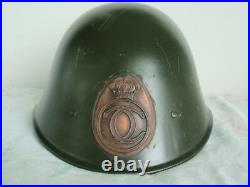
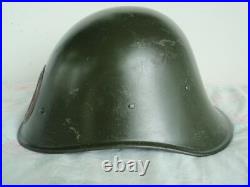
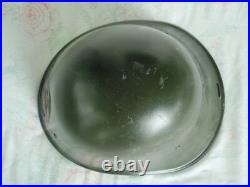
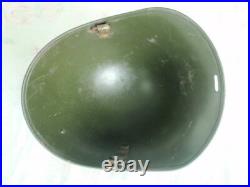

100% ORIGINAL ISSUE PIECE. Argentina, Brazil, Chile, Colombia, Romania, Bulgaria, Mexico, China, Macau, Turkey, United Arab Emirates, Montenegro. CANADA, USA, UK, IRELAND, AUSTRIA, DENMARK, SWEDEN, NORWAY, FINLAND, GERMANY, FRANCE, BELGIUM, ITALY, SWITZERLAND, NETHERLANDS, LUXEMBOURG, AUSTRALIA, AND NEW ZEALAND. The item “ROMANIA KINGDOM 1930’S ISSUE KING CAROL II COMBAT HELMET. RARE! VF+ MEDAL” is in sale since Saturday, August 3, 2019. This item is in the category “Collectibles\Militaria\1919-38\Original Period Items”. The seller is “worldmedals” and is located in NS. This item can be shipped to Canada, United States.


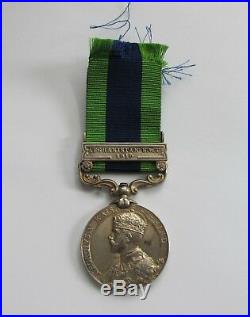
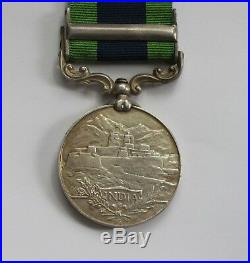
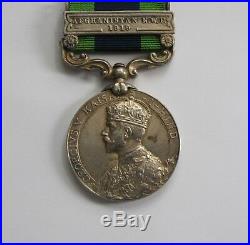
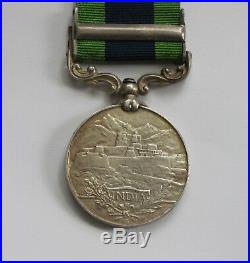
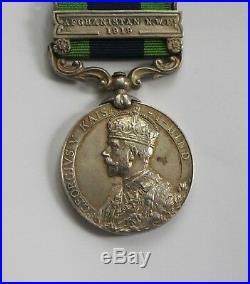
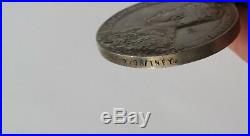
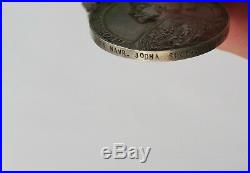

BRITISH INDIA General Service medal 1908 – 1935 with AFGHANISTAN N. Awarded to BRITISH & INDIAN UNITS who served in the AFGHANISTAN 1919 N. STAMPED ON THE EDGE 74 HAVR. 2 / 98 INFY. ORIGINAL MEDAL WITH ORIGINAL BAR & RIBBON. MADE FROM SOLID STERLING SILVER, 44 GRAMS WEIGHT. PERFECT FOR YOUR MILITARTY COLLECTION. WORLD WILL BE CALCULATED. Track Page Views With. Auctiva’s FREE Counter. The item “British INDIA General service Afghanistan NWF War combat silver medal 1919″ is in sale since Tuesday, October 30, 2018. This item is in the category “Collectibles\Militaria\1919-38\Original Period Items”. The seller is “rokas” and is located in Calgary, Alberta. This item can be shipped worldwide.
- Country/Region of Manufacture: United Kingdom
- Modified Item: No
































































